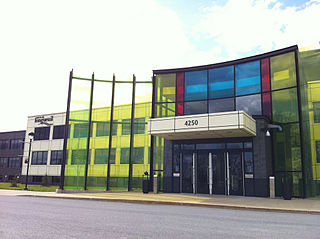
Longueuil is a city in the province of Quebec, Canada. It is the seat of the Montérégie administrative region and the central city of the urban agglomeration of Longueuil. It sits on the south shore of the Saint Lawrence River directly across from Montreal. The population as of the Canada 2021 Census totalled 254,483, making it Montreal's second largest suburb, the fifth most populous city in Quebec and twentieth largest in Canada.
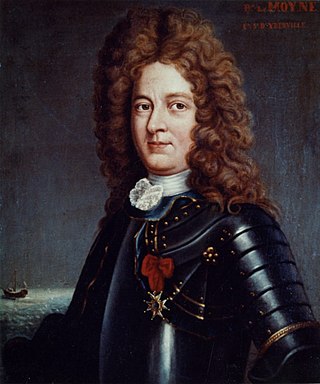
Pierre Le Moyne d'Iberville or Sieur d'Iberville was a French soldier, explorer, colonial administrator, and trader. He is noted for founding the colony of Louisiana in New France. He was born in Montreal to French colonist parents.

Louis de Buade, Comte de Frontenac et de Palluau was a French soldier, courtier, and Governor General of New France in North America from 1672 to 1682, and again from 1689 to his death in 1698. He established a number of Forts on the Great Lakes and engaged in a series of battles against the English and the Iroquois.

Deschambault-Grondines is a municipality located in the Portneuf Regional County Municipality (RCM), in the Capitale-Nationale region, Quebec, Canada.

Jacques-René de Brisay, Marquis de Denonville was the Governor General of New France from 1685 to 1689 and was an important figure during the intermittent conflict between New France and the Iroquois known as the Beaver Wars.

Le Moyne is a neighbourhood in Longueuil, Quebec, part of the borough of Le Vieux-Longueuil, and a former city. Le Moyne makes up 2% of the total area of Le Vieux-Longueuil borough and is the only neighbourhood of the borough that was not part of the pre-2002 city of Longueuil. Residents of Le Moyne are called Le Moynois.
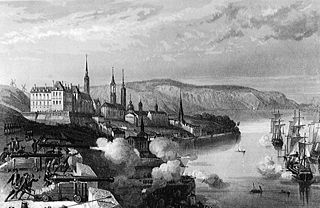
The Battle of Québec was fought in October 1690 between the colonies of New France and Massachusetts Bay, then ruled by the kingdoms of France and England, respectively. It was the first time Québec's defences were tested.
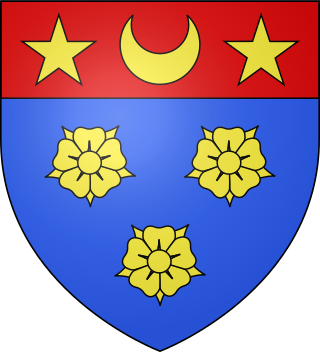
Baron de Longueuil is a title of French nobility that was granted originally by King Louis XIV of France to a Norman military officer, Charles le Moyne de Longueuil. Its continuing recognition since the cession of Canada by France to Britain is based on the Treaty of Paris (1763), which reserved to those of French descent all rights which they had enjoyed before the cession.

Antoine Juchereau Duchesnay was the Seigneur of Beauport, Saint-Denis, Fossambault, Gaudarville, and Saint-Roch-des-Aulnaies. He fought with the Troupes de Marine and after the British Conquest of New France joined the British Army, defending Fort Saint-Jean where he was captured and imprisoned by the Americans in 1775. He represented Buckingham County in the 1st Parliament of Lower Canada and was afterwards appointed a member of the Executive Council of Lower Canada.

Charles le Moyne de Longueuil et de Châteauguay, was a French officer and merchant who was a prominent figure in the early days of Montreal. Born in Dieppe, France in Normandy, he came to New France in 1641. He became lord of Longueuil in Canada.
Jacques Le Ber was a merchant and seigneur in Montreal, New France. In 1686 he was ennobled by Louis XIV and took the title Jacques Le Ber de Saint-Paul de Senneville, based on his hometown of Senneville-sur-Fécamp.
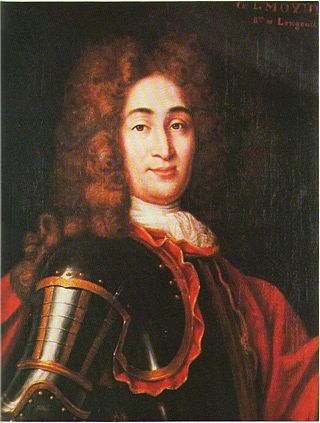
Charles (II) le Moyne de Longueuil, Baron de Longueuil was the first native-born Canadian to be made Baron in New France.
Jean Bochart de Champigny, Sieur de Noroy et de Verneuil, was Intendant of New France from 1686 to 1702. His mandate was one of the longest, rivalling those of Hocquart and Bégon. He served as intendant during the terms of Governors Denonville, Frontenac, and Callière, and was in office at the time of King William's War, the Lachine Massacre, the Battle of Quebec, and the Great Peace of Montreal.

Old Longueuil is a historic neighbourhood located in the borough of the same name, in the city of Longueuil, Quebec, Canada. The neighbourhood essentially corresponds to the pre-1961 city of Longueuil and is bordered to the west by Joliette street, north by Saint Lawrence River and east by d'Augerne street, while its southern limits varies from one source to another but can go as far as De Gentilly street in some definitions

The Co-Cathedral of Saint-Antoine-de-Padoue is a co-cathedral in Longueuil, Quebec, Canada, on Montreal's south shore. It is located on the corner of Rue Saint-Charles and Chemin Chambly in the Borough of Le Vieux-Longueuil. It is dedicated to St. Anthony of Padua. The cathedral houses the remains of the Blessed Marie-Rose Durocher, the foundress of the Sisters of the Holy Names of Jesus and Mary.

Le Ber-Le Moyne House is the oldest complete building in Montreal, Quebec, Canada, built between 1669 and 1671. It is located in the borough of Lachine, bordering the Saint Lawrence River, between the Lachine Rapids and Lake Saint-Louis. It is a recognized National Historic Site of Canada since June 19, 2002. The Le Ber-Le Moyne site and its archaeological collection have also been classified as heritage assets by the ministère de la Culture et des communications du Québec since 2001.

Charles III Le Moyne (Longueuil, was the second baron de Longueuil. He succeeded his father Charles le Moyne de Longueuil, Baron de Longueuil in 1729. He became Governor of Montreal, and administrator by interim of New France.
Paul-Joseph Le Moyne de Longueuil was a seigneur and colonial army officer in New France and governor of Trois-Rivières from 1757 to 1760.
Joseph-Dominique-Emmanuel Le Moyne de Longueuil was a soldier, seigneur and politician in New France and Quebec.















